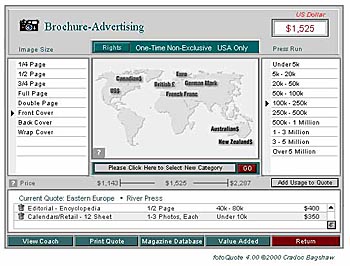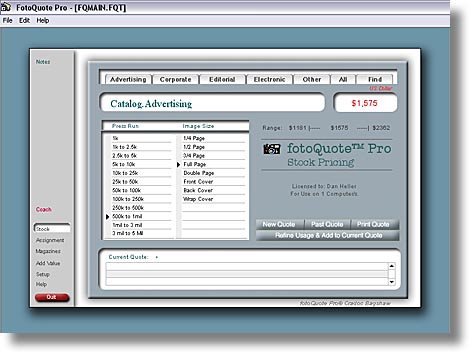|
Markers indicate locations for photos on this page.
Accuracy responsibility of Google Maps
Google Map Goes Here
If you see this text, the map is still loading (or there's an error). |
"Bob, I would license that image for $200 for that use!" Bzzzzzt! "Sorry, Dan, but that photo is worth $3000 for that use!" (Huge gasp from audience.)
"Ok contestants, this next item is the same photo to a different company, for use in a magazine ad running one year, for a circulation of 1,000,000 units." Finding the right price points for selling photography or bidding on an assignment is the Holy Grail of the photography business. What do you charge for licensing an image for an ad in a magazine, a billboard, or for a local merchant's Web site? What about pricing a photo shoot of a parade for one of the corporate sponsors? How about a wedding? No matter what the product or the service, pricing is the most daunting problem facing all photographers in their first years, and it seems there is no sure-fire method to finding what works. The natural thing to do is research price charts or guidelines, but as the industry has evolved and competition has grown, such data points are no longer reliable. What's more, it's not that simple. Even veteran professionals get frustrated by the volatility in pricing, not just among different clients, but in the way the same product can vary dramatically from one case to the next. Most pro photographers and websites that attempt to assist in pricing photography approach the subject as a matter of fine-tuning negotiation skills. But you cannot teach negotiation strategies. It has to be learned through empirical experience. More importantly, it's imperative that this experience be a part of a much broader career strategy. One with specific direction and intent. Any given business act (shooting an assignment or licensing an image) should be part of that longer-term strategy for it to be beneficial. Most photographers don't think long term—they want to shoot and get paid. And that's the reason why most photographers fail at the business, and why most who try to help them fail at their advice.
When the career goals and strategies are well-developed and articulated in one's mind, new and different ideas, goals and objectives get weaved into negotiations, which turns out to have win-win benefits. That is, what might seem like a "bad deal" to a short-sighted photographer who only seeks the highest return for an assignment might actually be quite beneficial to the longer term career path—which itself yields higher financial returns. This concept is discussed at greater length in the chapter, Photography and Business Sense. The unmentioned variable in this concept is marketing. It not only has an impact on pricing in the short-term negotiations, but has feedback-value. That is, the non-financial benefits associated with having gotten the gig (or the license agreement), which adds credibility and increased perceived value to the photographer for the next client, contract, or negotiation. These small, incremental successes build up over time, and, when combined with other acts in the career-building process, add to the longer-term financial growth. In the end, marketing strategies frame how a product is packaged and presented. Who does that presentation has so much more to do with perception of price than what most people think (or want to believe), that to understand pricing, one must also have a firm grasp on the nature of marketing. That discussion is covered in Marketing your Photography Business. Nevertheless, with all these elements involved in the recipe, the one take-away message one must commit to memory is this:
The question that many photographers face when getting started is that they don't yet know where on that broad spectrum between high-volume and low-volume they will ultimately fall. Invariably, such photographers (and readers of this text) are probably unclear on their longer term objectives, but are at this very moment faced with a sales opportunity for an image and they need some guidance on guidelines. To that, I can only provide this simplistic advice: take whatever you can get—it doesn't matter. That's right, if your career is going to be long and illustrious, it really won't matter much in the end if you found you got way underpaid in the beginning. The real value is the important lessons you learn while diving into the water and learning to swim. The mere value of the experience itself trumps whether or not you get it right in the beginning. Of course, you want to learn the most you can, which is why you need to continue reading this chapter.
This chapter looks at the various strategies associated with pricing
images or services. This includes more than just pricing "policies," which
may be rules of thumb for price adjustments based on certain variables.
"Strategies" exist at a higher level, where policies are modified according
to an intuitive sense for sales as unique transactions.
On the flip side, these characteristics become benefits: more people
can more quickly identify and understand a photograph than a painting,
making it more suitable for commercial use. That it can be easily
reproduced makes it easier to sell in quantity in broader markets.
But, these contradictory qualities don't always work in tandem.
For example, the value of an image is higher if it is being used to
advertise an expensive vacation package to Hawaii in Conde Naste's
Traveler magazine, versus an image used for a local newspaper ad for
a pet shop. The fact that it's an image has, in itself, no real
value. Its perceived value is defined more by the buyer. (Hence, the
seller has to de-tangle his emotional attachment to it.) Therefore, the
product must be regarded as something that has no value until it is
presented to the appropriate buyers in an appropriate market segment.
This is vague right now, but that's why it's important to understand
marketing.
For any pricing structure to work, it must lie within the circle of plausible possibilities. That is, the customer has to believe it. Setting arbitrary prices can be intuitively seen by any buyer as just that: arbitrary. And you can't set prices high with the expectation that you'll just negotiate from there—such a strategy will only alienate more prospective buyers. You can't begin the sales process if you don't start with the right pricing structure. As mentioned in the beginning of the chapter, most people think of pricing as static data that can be listed in a chart. Indeed, there are such charts, and you may end up making some. But how you make them, and how you use them are important parts of the larger strategy. So, we must begin by establishing a plausible pricing structure for your products in your marketplace. I propose the following foundation:
There are several elements to this statement that need to be made part of your sales paradigm.
I didn't say "Pricing photography...", I said, "a photograph." Because each image is different, it will likely be of more or less value to any given client. You must establish a mindset that disassociates photography from the "commodity" pricing model so you can perceive sales as a process. This won't always apply, of course, and there will be many times where you sell directly from your published price list (discussed below). Negotiated sales requires breaking from the "price list" paradigm, and that will happen more often than not. Many photographers resist doing this, because they feel they would be regarded as weak negotiators. That is definitely not true. Weak negotiators are so, not because they "deviate" from the price list, it's because they do so poorly. Accepting the fact that price lists are not etched in stone requires a mindset that you are not selling a bunch of identical widgets, nor to equally qualified clients.
It's counter-productive to think that you're going to set price points that (a) people will either accept or reject, or (b) apply to the broader global market. Selling is ultimately about negotiation, so your pricing tables should really be thought of as starting points for discussion. It's true that if you're selling "commodity products," like calendars or even prints, one rarely deviates from the price list. However, when it comes to a consultive sale, where someone wants to license an image of individual and unique uses, variables come into play that don't apply to the commodity market.
In summary, don't look at price lists strictly as the high point, after which you expect to come down. They are best thought of as "typical uses," where different terms and conditions can make the prices rise or fall accordingly. Your published "policies" may even articulate this point. (This sets up the buyer for expecting to negotiate.)
As noted at the top of this section, you can't expect a price list to apply to the global market. Granted, that's a very loose and vague term. We live in a global market, but I'm not referring to geographical boundaries. You must identify your target market, preferably one that you know quite well (perhaps because you came from that industry in a previous career). Your pricing cannot be arbitrary; it has to be based on either empirical experience, where you know the business model of your buyers (consultive sales), or it has to be researched, where you understand the buying behavior of the market segment (such as commodity products). Whoever the buyer is usually has a preconceived notion of the value of what they're buying before they see your product, and you have to either meet those expectations, or convincingly justify a deviation. A discussion of this is found in Photography and Business Sense.
When photographers seek out pricing tables based on published reports
of historical sales, they fail to realize that those prices are based
on negotiation sessions for specific uses, by specific clients, for
specific markets. Having data about ranges of prices for very narrow
market segments may be useful, but the narrower the segment, the
less likely it is that there is a sufficient sampling of data points
to give validity to any of them. In short, they're all circumstantial.
We'll address this again later.
Figuring out initial price points is the hardest part, because you need to establish that circle of plausible possibilities we discussed earlier. So frustrating, this is, that you may think you should have taken up cooking instead. (I'm just kidding; cooking isn't nearly as fun as photography because it requires a kitchen, which is dangerous for those of us who are cleaning-impaired.) So, where do you establish your initial price points? Doing research on this is like having a severe mental disorder with hundreds of voices in your head: you don't know whom to believe! Charts, research reports, coaching software, prices quoted on other photographer's sites, what your friend, Ed, told you, peer pressure (what other photographers on the internet claim), and industry associations all have something to say about the subject. Rarely will any of these sources agree on actual numbers, but they'll all claim to be right. The thing is, sometimes they are right! Given the thousands who constantly chime in with opinions, such as, "Hey Steve! Your advice to quote $500 for that image was right on!" It can sometimes appear that someone knows something more than the others. When it comes to anecdotal evidence, remember this quip:
There are various philosophies about the most effective strategy for determining appropriate price points. Most photo-industry groups point to formulas for determining prices based on historical models, for example. The price for an image licensed to a magazine was typically based on their advertising rates. For a full page ad, the theory held, if the magazine charges X to an advertiser, your price would be a percentage of X. While this certainly feels fair and beneficial to both sides of the deal, this pricing strategy is not as well received (if even recognized) to a degree necessary to recommend this method. Using this form of "formula pricing" will yield just as arbitrary results as reading your horoscope will predict the future (unless you're a Libra and your moon is in Aquarius). While it's true that such formulas were the standard for the industry decades ago, and some media companies still use such methods for determining pricing, these exceptional cases cannot be relied upon in the general open market (unless you're a Leo).
There are too many problems with this data, including:
Still, the search for some basis for pricing is desirable, and while I would partially agree, I raise the second reason the numbers aren't justified: many license agreements are often based on multiple images, multiple uses, non-standard sizes, or any number of complex exceptions that outnumber the "normal" rates described by a price list. The real world of image licensing so rarely is based on simple text-book like scenarios, that the price lists, once again, are deceptive to the point of destructive.
Does that make programs like Fotoquote and other price lists invalid?
The answer varies, depending on how new you are to the business.
A positive spin is that it's a tool, and you have to know how to
use it wisely for it to be effective. Most people don't, which is
why most will will be harmed by it than helped. For the extremely
experienced photographer who already knows the nuances of the industry,
but has come across an unusual circumstance where it'd be helpful to
know how someone else dealt with a similar situation, such data can
provide abstract insight that only a seasoned pro can interpret with
the proper number of grains of salt.
That should be the process for any photographer breaking into his chosen fields of photography, whether journalism, advertising, or even the adult market. No industry is simple, so it's best approached from the inside. If you have an opportunity to quote an assignment and are completely lost about where to start the bidding, you should review the checklist from Photography and Business Sense. This won't help you determine a good bidding price, but it will remind you that the value of the assignment itself is probably worth far more than the money you may receive from it. (Therefore, you should do what you can to get the gig.) That's not to suggest you should bid low, just bid "appropriately," keeping the bigger picture in mind. If you lose the opportunity, you could be losing more than just the money you didn't get.
If you are reticent to establish your price points because you think
they'll be set in stone, don't worry. I've modified my price lists many
times in my early years as experiences dictated and refinement was
necessary. In fact, as market conditions change, price revisions are
inevitable. So, this is an ongoing process.
While negotiation is a test of wits, and you can perform better or worse based on your command of communication (written or oral), it's important never to forget what you're negotiating about. It's not about the product, it's the perception of value, as discussed earlier. This is not a straightforward science, because it doesn't start out having anything to do with your images. It's the sense of value that the client has for the use of an image—any image. If the client has an ad to produce, there's a sense of value the company has for the photo that will eventually become part of that ad. Some clients value text, others layout, others "imagery." Determine what's important to that client before you enter into negotiation, but no matter what, understand that you're not going to change this perception. You may be completely correct in your client's poor marketing sense, and that he should value images more highly in his overall message, but not everyone feels this way. If he does, that's great, but you're still in the same boat: you have to convince him of the value of your images (or the one(s) he's selected). Where you expect to end up, however, must take into account the client's abstract sense of value for images in the first place.
The next most important thing is how critical the image is to the client's need. If the image is to be used to promote a highly priced or image-branded product, like a cruise ship by a major cruise line's brochure, it's going to garner a much higher price than the same image used by an editorial magazine that writes about one of the trips from that cruise line. Same image, different use, different client. Hence, different perceived need. Where it gets more complicated in when multiple variables are at play. To illustrate a more realistic example, let's consider two scenarios. In each case, we have two photographers, each of differing skills and backgrounds. One shoots head-shots of corporate executives, the other shoots travel photography for vacation magazines.
Now, consider each of these questions for each scenario:
In a sense, you could say that the "job" is identical: shoot the corporate headquarters building. Shouldn't the pay be the same? Unless both companies know each other and exchange notes, the likely case is that their price expectations are going to be based on the fees of the photographer they know. They're asking for a competitive bid as a sort of validation check—a form of "due diligence," as it were. Think about the different ways this could play out and hold that in your mind as you consider the next case.
The example above illustrates how perception of price and value play
into the decision-making processes on all sides. Pricing "policies"
are useful for handling whether to add or subtract a little here and
there for variations on use. But, as you can see, it has nothing to
do with how you handle negotiations.
Sticker Shock from the initial price list is probably the biggest reason sales don't happen. And it isn't always because prices are high. Clients can dismiss products because they're too inexpensive, too. For example, the rage over royalty-free images on CDs were initially hot, but time has proven to most serious buyers that the images they get are pretty useless. The $300 or so that they spent isn't the real cost, it's the lost time associated with searching volumes of CDs, only to come up with nothing that upsets clients more. Furthermore, sticker shock isn't always from the client; you might dismiss a client who offers a price you feel is so low, it's not worth negotiating. When you do negotiate, how do you find the middle? What is the "best" price? Again, review the checklist in Photography and Business Sense for other benefits beyond just the money you receive: you don't always need to reach the highest price, just the best price.
Some clients actually do this: they dismiss price lists and negotiations completely and just offer a price. This is actually fairly common among bigger publishers or those who license images frequently. Here, the negotiation is easy: you accept or reject. (It may or may not be a good deal, but it is easy!) Here, the business decision changes a little. There's no question that by not taking the offer, that's $250 you didn't get. The question is what are the longer-term ramifications of this decision? One argument is that you've established a lower price point, making it more difficult to get a higher price from the same client in the future; or, that you've set your expectations unreasonably low, and that you will underbid future opportunities, undermining your own business. Many who work in the industry would also curse you for doing so, arguing that you erode prices across the board, affecting not just your own lower rate, but that of the industry as a whole.
For my business model, anything that requires time is costly, and I want to be paid for it. Whatever I have to do to close a sale is work I'm not doing for any other purpose than that sale. Once the sale is done, the time and work I invested is lost, and that's lost opportunity to be building my business in a much broader sense. Even the process of negotiation is time-consuming. The more work it requires, the more money I'm going to charge. Negotiations start on my price list, then I get to know my client (this isn't a drawn out process; it's a short exchange of emails), and then it's about how much time I have to spend. Broadly speaking, I like to confine any work I do to things that contribute to my business as a whole. When I work on my Web site, that work enhances my entire business. When I do research, I am getting new information that eventually translates to optimized prices. When I produce marketing materials, I do so in a way that I can reuse them over and over. Anytime I have to do something again is time wasted. Similarly, immediate payment speaks loudly, because I hate having to bug people in email about late payments. When I can spend time doing things that generate new revenue, I'm happy. Slow me down, I'm unhappy and I charge money. (Ok, I'm happy then too, but I still charge money.) I stand firm when I know I can stand firm.
An example that illustrates how my thinking applies to a "low-bid" offer follows: I happened to get two calls at the same time from two different people: one in Kansas, and one in New York City. Both were realtors, both dealt with high-end real estate property in their areas, and both wanted to use a (different) photo for a 4x6" postcard used for direct mailing to a targeted mailing list. The NYC realtor sold properties only over $3M; the Kansas realtor's properties maybe would get to $250K. By fortunate coincidence, I talked to the Kansas guy first. He looked at the pricing guidelines on my site, and paid the listed rate of $645. The NYC realtor wouldn't even consider it. She wanted only to use the image in exchange for her putting my name and website (in small print) on the card. As most clients will tell you sooner or later in a negotiation, "your name will be seen by thousands of people!" (Clients always use this as a form of negotiation to beat down prices. They also believe they know how to market you better than you do.) Anyway, there was just no way she was going to pay a dime over $100 for the image. But, as I've pointed out, that's $100 I would otherwise not have at all.
I didn't take the sale to the NY client, probably for reasons other than what you predicted. First, while it wasn't a main issue, there was an unusual problem in that I didn't immediately have the image in digital format, ready to go. I would have had to go locate the slide, scan it, and photo-touch it for dust and color-calibration before giving it to her. This often takes long enough that no sale is worth less than $300 (for me). The more important reason was that she was just a difficult person. You never really appreciate how costly it is in time and other intangibles to deal with such people till you do it a few times. You quickly learn that it's never about the money; if they have a problem or an issue, you have to deal with them. A lot. If you think they were difficult in negotiations, imagine how they'll be as you continue with business. Whatever their problem is, it won't be an easy one to solve, because they often have issues well beyond that of business. Difficult people are so for reasons other than business, and they will continue to be difficult as long as you continue to work with them.
The third criteria, which can apply to many more types of sales,
was that I had no future opportunity with this client. She was a
realtor that didn't license images often, so I had no incentive to
give her a discount. I've had clients that are in need images on a
regular basis, and these customers deserve (and get) price breaks.
In some cases, people "promise" to be future clients, and I always
counter with, "great! So, I'll give you a discount by selling you
multiple images at the same time (now), and deliver the future
images to you when you need them." This always shows their true
colors. (Hint: I've never had a long-term client actually tell me
he was going to be before the sale.)
This often comes up because photographers are often offered a photo credit in exchange for using an image in a catalog, for example. Clients want to minimize their costs, and they know that photographers need help getting visibility. It's their perception that the photo credit in exchange for the image is mutually beneficial. Some in the photo industry say this is always bad, because it devalues your photos, and makes it harder for other photographers to keep their prices high. None of this is true. There's certainly nothing "wrong" with giving away photos for use by a client in exchange for something that isn't cash. The question is whether what you get in return actually contributes to your business growth or evolution. Is a photo credit a good barter exchange for your photo? During a time when the best (and only) way to market yourself to prospective buyers and agencies was to have a strong portfolio of name-brand clients in great glossy-looking catalogs and magazines to show that you had experience and panache. But such marketing techniques these days is limited to a tiny portion of the photo industry these days, mostly fashion and advertising photographers. These days, the usefulness of a portfolio is waning along with film itself. You may still find many old-school pro photographers who still use film, and still use portfolios, but the vast majority of new photo business "development" is done digitally and on the web. What this has to do with pricing of images is simply that sales and marketing go hand in hand. Marketing opportunities may affect the price you charge for a photo, even to the point of free. Giving your work to clients is fine if their use of the image actually helps promote your business. Catalogs don't do that. Why? Because photos buyers don't look at catalogs, and the use of portfolios is less common (or effective) in self-promotion. Consumers look at catalogs, which means that you could conceivably permit a free use of the image in exchange for the photo credit giving your web address (in a font size no smaller than the rest of the text on the page). Having your website listed is far superior to your "name" because that's like a free advertisement. Well, it has value if your photo business involves the web and you target consumers. (If not, then it's not such a great value.) Another way to use "free" in proposals is to offer free use of your photos on their website in exchange for their paying for the print uses. Here, you could stipulate that the web use include a link back to your site. A third alternative is to let them use the image for free so long as they purchase another one of the same or higher value. This is a successful way to rope clients in and keep them coming back. Of course, you also have to prepare to execute this agreement properly—never ever let a client use the future tense as part of an agreement. That is, don't let them say, "we will license another image at some future date." They will almost assuredly never do so. Even if it's written into a contract, they don't care. Instead, make them pay today, and they can have the use of this image today and another image at a future date when they choose. This way, money is paid and if they flake out on their free image, then that's their loss, not yours. When I got started, I've used techniques like free use of images in exchange for free or discounted travel. Today, I still engage in giving away photos or other services if I feel the opportunity I'm getting in return ultimately leads to more or better business. But what I considered "valuable" yesterday is not the same as what I do today. No pro should ever get out of that mindset.
You should always look at any "exchange" in terms of how it grows or
contributes to business. It isn't always cash, and when it isn't,
understand the value of what you may get in return and weigh it
accordingly. If you ask, "should I give the image in exchange for a photo
credit," and you genuinely don't know the answer to that, then the answer
for you is no. Your business may evolve someday to the point where
such a barter might, in fact, be valuable. The same strategy doesn't
work for everyone. And that's what it all boils down to: strategy. Know
what it is you need or want, and be willing to barter in exchange for
those things. Unless you know you need it, you don't. Don't try to
be like a chipmunk, hoarding things that you think you might need in
the future. Your cheeks can get pretty big and you'll invariably make
poorer choices, thereby passing up better choices that lead to better
opportunities later.
If I had to part with any last piece of advice, it'd be to maintain critical thinking. I found that simply knowing how the industry worked gave me better negotiation skills and a more credible platform to state my case for higher rates. But, the reality is that pricing is and always will be, an amorphous concept that we never really grasp. You just have to get better at it without expecting to perfect it.
Click to recommend this page: |
|










 There are software programs that can be purchased to assist in coaching
pricing strategies. An example of this is one called Fotoquote, which
is built from a database of statistical pricing from sources in the photo
industry during the previous year. You can look up hundreds of different
photo uses, with thousands of different variations on those uses, and see
how the prices range from one extreme to another. To be sure, each of
these provides some useful context by which you can gauge pricing
guidelines, complete with discussions on people's empirical experiences
for such markets.
There are software programs that can be purchased to assist in coaching
pricing strategies. An example of this is one called Fotoquote, which
is built from a database of statistical pricing from sources in the photo
industry during the previous year. You can look up hundreds of different
photo uses, with thousands of different variations on those uses, and see
how the prices range from one extreme to another. To be sure, each of
these provides some useful context by which you can gauge pricing
guidelines, complete with discussions on people's empirical experiences
for such markets.
















